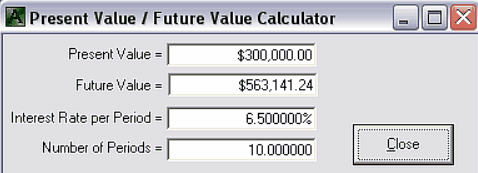Average Annual Rates are Misleading
Real Estate Boards should be clear and factual when reporting historical Real Estate growth figures (National Post, “Dream of ownership….” Page PH2 Saturday Oct 28th 2006).
Dorothy Mason, President of the Toronto Real Estate Board states in her article that over the past decade (10 years) home prices in the GTA “have climbed at an average annual rate of about 6% to 7%”. What is she really trying to say to the readers? I can only assume she is dumbing it down for the sake of the readers?
An average represents data by a single number by dividing the sum of two or more quantities by the number of quantities.
Mathematically speaking it is ludicrous to quote average annual rates for growth instead of annual compounded rates? Compounding is growth upon growth, plain and simple! Bacteria in petri dishes grow at compounded rates, some chemical reactions progress or grow at compounded rates, Statistics Canada’s consumer price index numbers appreciate at compounded rates, interest on missed mortgage payments grow at compounded rates and finally financial growth figures are always specified (or should be) as annual compounded rates. Professional Accountants knows the only meaningful way of comparing numbers is via present value/future value calculations that are based upon annual compounded rates. Quoting average annual rates is misleading and its use exaggerates the appreciation or growth! The following example will prove the point.
A $300,000 home growing (appreciating) at an annual compounded rate of 6.5% over ten years would be worth $563,141 ten years from now. That represents a financial gain of $263,141over ten years

$263,141 divided by $300,000 is an 87.7% increase over ten years or an 8.77% increase for one year “averaged “over ten years. This mathematical technique is often used in mutual fund reporting in order to exaggerate a funds growth!
An annual compounded rate of 6.5% growth could be reported as an average annual rate of 8.77% thus exaggerating the growth.
If the annual compounded rate was used in reporting growth rates or appreciation, there would be less confusion! Whether growth rates concern mutual funds, real estate or environmental matters at least the method would be consistent! Some may say 6.5% compared to an exaggerated 8.77% is not a big deal.
However, using the same example but using a time frame of 20 years the exaggeration is almost double! An actual annual compounded rate of growth of 6.5% stated as the average annual rate for 20 years would be exaggerated as 12.62%. That is very significant difference! Call me silly, but I would prefer knowing that my investment is really growing at 6.5% a year instead of an alleged growth rate of 12.62%.
